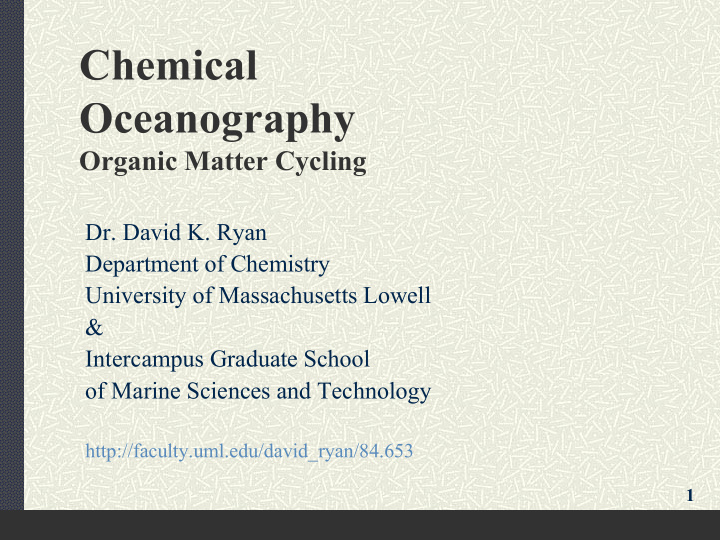



Chemical Oceanography Organic Matter Cycling Dr. David K. Ryan Department of Chemistry University of Massachusetts Lowell & Intercampus Graduate School of Marine Sciences and Technology http://faculty.uml.edu/david_ryan/84.653 1
Organic Compounds in the Sea Where do they come from? What are they? Why are they important? Where do they go? Read: Emerson & Hedges Chapters 8 & 11 Libes Chapters 22 & 23 (posted on website) 2
Organic compounds produced during Primary Production Phytoplankton fix CO 2 to make “soft parts” (organic) (Broecker & Peng, Chapter 1) Consumed by other organisms to make their soft tissue All organisms exude and excrete soluble organic compounds Particulate organics arise from dead organisms (detritus) and fecal material from live organisms 3
Libes Fig 22.1 Factors influencing OM distribution 4
Primary Production continued Organic particles sink under the influence of gravity Become degraded by bacteria as they sink Consequently, the destruction of organic matter occurs at greater depth than formation Destroyed organics are remineralized to 2- & NO 3 inorganic species (e.g., CO 3 - ) Deep ocean becomes enriched in nutrients 5
Diagenesis = change 6 6
Broecker & Peng Figure 1.1 7
Primary Production continued Large particles are more likely to make it all the way to the sediments and be buried Greater than 99% of organic matter is remineralized, very little reaches sediments Is there a consequence of the above info for large scale iron fertilization of the oceans? 8
Primary Production continued Large particles are more likely to make it all the way to the sediments and be buried Greater than 99% of organic matter is remineralized, very little reaches sediments Is there a consequence of the above info for large scale iron fertilization of the oceans? Yes, stimulating primary production at the surface results in an increased production of particulate organic material that is remineralized at greater depths and stores carbon in the deep ocean. 9
100% 10% 1% 0.1% 10
Marine Snow 11
Marine Snow Verdugo et al., 2004 “The oceanic gel phase: a bridge in the DOM–POM continuum” Marine Chemistry 92, 67-85. Handout posted on website, Course Materials 12
Nomenclature & Units for Carbon Organic compounds are carbon containing (except oxides, carbonate minerals, elemental) The symbol for carbon is C Organic materials in the ocean are sometimes discussed as a whole, including all compounds regardless of structure Specifying concentrations is best done in grams or moles of carbon (C) per L or kg of seawater μ M C or mg C/L or mg C/kg 13
Concentrations of organic material expressed in μ M = micromoles of C per liter of solution Millero, 1996 Table 9.8 in Millero, 2007 14
Nomenclature & Units for Carbon DOC is most common abbreviation – specifies C DOM or NOM concentrations may differ from DOC by a factor of 2 to account for % C (Ryan 2013) 15
Libes, 1992 16
Relatively New Nomenclature CDOM is colored or chromophoric DOM Term used to distinguish light absorbing material from OM that has no light absorption or color Typically measured spectrophotometrically by: - UV/vis absorption measurements - Fluorescence spectrometry 17
Humic Materials or Humic Substances Complex organic molecules of natural origin Much is known about properties/importance Some is known about structural components Little is known about exact chemical nature or exact structure – because: Complexity Deficiencies in analytical Heterogeneity techniques Concentrations Interfering species 18
Organic Compounds in the Sea Where do they come from? What are they? Hydrocarbons Carbohydrates (polysaccharides), sugars Lipids, fats, waxes, oils, fatty acids Pigments Nucleic acids, RNA, DNA Amino acids, polypeptides, proteins, enzymes Low molecular weight carboxylic acids Humic Substances 19
Organic Compounds in the Sea Where do they come from? Primary Production Riverine and Terrestrial Runoff To a much lesser extent Atmospheric Deposition Sediment Diffusion & Resuspension Groundwater input Vents, etc. 20
Morel, 1983 21
What is this stuff? Morel, 1983 22
23
Libes, 1992 20 24
Libes, 1992 25
um) Millero, 1996 26
Organic Compounds in the Sea Where do they come from? Primary Production Riverine and Terrestrial Runoff To a much lesser extent Atmospheric Deposition Sediment Diffusion & Resuspension Groundwater input Vents, etc. 27
Organic Compounds in the Sea Where do they come from? What are they? POC Why are they important? Detritus Where do they go? Fecal Mat. DOC Biological molecules (lipids, proteins, carbohydrates, etc., etc.) Hydrocarbons Humic Materials (=other stuff) 28
All Dissolved Organic Compounds OC DOC Dissolved Carbon NOC Organic OM Matter Natural NOM Humic Subset DOM Materials HM Humic Substances HS CDOM Humic Acid HA Fulvic Acid FA Chromophoric or Colored DOM Ryan & Zhu 2013 29
Carbon Cycle Libes, 1992 Inventories in 10 15 g C = BMT Fluxes (arrows) 10 15 g C/yr 30
Distribution of Organic Carbon (a) Major compartments in the global ocean (b) Major compartments for the planet Cauwet, 1978 31
Recommend
More recommend